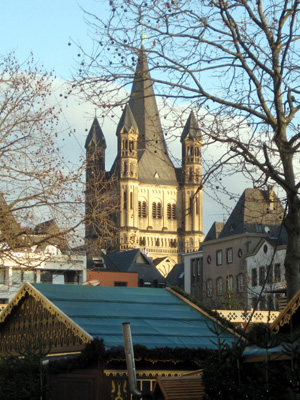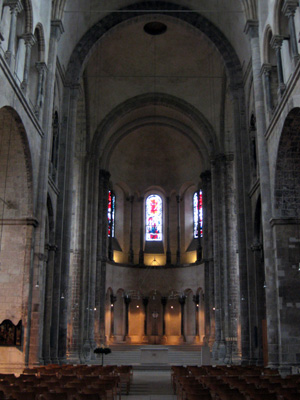| |
 |
 |
 |
| Comment on this report, or find other reports. |
 |
| Our Mystery Worshippers are volunteers who warm church pews for us around the world. If you'd like to become a Mystery Worshipper, start here. |
 |
| Find out how to reproduce this report in your church magazine or website. |
|
|
| 2963: Great St Martin, Cologne, Germany |
 |
 |
 |
Mystery Worshipper: Kingsfold.
The church: Groß St Martin, (Great St Martin), Cologne, Germany.
Denomination: Roman Catholic, Archdiocese of Cologne.
The building: Great St Martin was originally built as a Benedictine abbey in the 12th century and was completed in the mid 14th century, with the subsequent addition of the spire during the 15th century. It is one of the twelve Romanesque churches in Cologne, and, like its fellows, was badly damaged during the war and rebuilt in the same style thereafter. From the outside, the building appears large and imposing. However, the interior space feels more intimate and welcoming. There is a carpeted area with lectern in front of a plain, simple altar. The apse end has been left unadorned to let the architecture speak for itself, and this simplicity of decoration continues throughout the church.
The church: Great St Martin has had a long and fascinating history well set out in the Wikipedia entry. There is a resident monastic community, Die Monastischen Gemeinschaft von Jerusalem (the Monastic Communities of Jerusalem), which is made up of both brothers and sisters and serves the parish.
The neighbourhood: Great St Martin is in the Altstadt (Old Town) area of Cologne, home to one of the many Christmas markets that are bustling at this time of year. It is tucked away amid cobbled streets and lanes and sudden open courtyards. Though the church is very visible on the skyline, especially when you look east at it from the Rhine, it’s surprisingly well hidden behind the buildings of the Altermarkt and set back in a courtyard surrounded by modern buildings and flats. This makes you suddenly feel as though you’re miles away from the bustle of the markets, though in reality they are close.
The cast: The resident community (on this occasion comprising four brothers, seven sisters and one “alongsider”). The celebrant was a visiting priest identified only as Father Georg, who if I understood correctly was visiting from a Benedictine house in Heidelberg.
The date & time: Thursday, 17 December 2015, 6.30pm.
What was the name of the service?
Heilige Messe (Holy Mass). Mass had been preceded by a period of silent prayer followed by vespers.
How full was the building?
There were about a dozen people for the silent prayer. Lots more folk turned up for vespers (some 45-50 people), and this rose to around 60 by the time we got to mass – plus the Community. All this seemed like quite a lot for a weekday evening mass.
Did anyone welcome you personally?
No. Though given that I arrived during the silent prayer, this is hardly surprising!
Was your pew comfortable?
There were chairs that looked very unpromising, but I’m going to give them a 9. They were substantially more comfortable than they looked, and even after a couple of hours I wasn’t wriggling.
How would you describe the pre-service
atmosphere?
Depends where you start. Prior to vespers there was a palpable stillness and quiet – that full emptiness or perhaps empty fullness – despite bells ringing for 10 minutes before vespers, and the bustle of some three dozen or so folk making their way into the church.
Vespers rolled straight into mass, so it was quiet and prayerful.
What were the exact opening words of the
service?
"Die Gnade unseres Herrn Jesus Christus, und die Liebe zu Gott, und die Gemeinschaft des Heiligen Geistes sei mit euch allen." (The grace of our Lord Jesus Christ, and the love of God, and the fellowship of the Holy Spirit be with you all.)
What books did the congregation use during the
service?
It was a home produced book of the hymns, responses, vespers and mass setting for Advent.
What musical instruments were played?
The organ. However, all sung parts of the service, such as the mass setting, propers and various acclamations and responses, were sung unaccompanied. The organ was only played after the sermon and during communion.
Did anything distract you?
You mean other than trying to work out what was actually being said – mentally translating it into English whilst simultaneously trying to note down the content in either or both languages without making myself obvious?
Was the worship stiff-upper-lip, happy clappy, or
what?
It was simultaneously simple, dignified and moving.
Exactly how long was the sermon?
10 minutes.
On a scale of 1-10, how good was the preacher?
9 – The rating in large part reflects the fact that, much to my surprise, I actually understood if not the exact words, certainly the gist of most of what was said. It was delivered calmly and clearly, which certainly helped!
In a nutshell, what was the sermon
about?
The gospel reading for the day was the genealogy of Jesus according to Matthew. Father Georg linked this to a list of the former abbots and priors of his Benedictine house in Heidelberg, going back years and years (I think – my German was a little challenged here) and with our own family histories, which also go back years and years. It’s all about God’s history with mankind. God has a long history with us, and a lot of patience! In Advent, this gospel is about the whole history of the world, and God’s coming is “real” history. This history of generations was, however, interrupted, since Joseph wasn’t actually Jesus’ father. God can interrupt history to break it or remake it. God can also make things new.
Which part of the service was like being in
heaven?
Actually having understood the greater part of what I’d heard and/or sung! More seriously, it felt very much as though this was where I needed to be at this point in time, and there was a strong sense of being upheld by the prayers of others. And something very heavenly indeed: I had been at mass a day or two earlier, where a sister had greeted me in German at the exchange of peace. I absent-mindedly replied in English, and she greeted me again, this time in English. At today's mass the same sister was there. Recognising me, she greeted me right off in English.
And which part was like being in... er... the other place?
Other than that it was dark inside the church before mass and so difficult to photograph – the lights were turned on during vespers but I wasn't either able or prepared to try to take a photo mid-worship – there was nothing even remotely purgatorial, let alone hellish.

What happened when you hung around after the service looking lost?
After the mass, the Sacrament was taken in procession to another chapel, after which there was adoration until shortly after midnight. Hanging around looking lost wasn’t something that you could really do under the circumstances.
How would you describe the after-service
coffee?
See above – it wasn’t going to happen. Fortunately, the Christmas markets were just around the corner, where I could find a more varieties of sausage than you thought possible, and as much glühwein (mulled wine) as I wanted.
How would you feel about making this church your regular (where 10 = ecstatic, 0 = terminal)?
9 – Geographical and denominational issues aside, it just felt right being there and sharing the pattern of worship. Whilst this report is of the mass, I did attend both the period of silent prayer and vespers that preceded it, and really appreciated the silence, space and prayer the worship as a whole created for me.
Did the service make you feel glad to be a
Christian?
Oh yes.
What one thing will you remember about all this in seven days' time?
The sister who remembered me from several days ago and shared the peace with me in English. I was very touched by this. If you’re reading this at all, Sister: ich kann nur sagen “Danke, Schwester, es bedeutet mir sehr viel“ (I can only say, "Thank you, Sister, it meant a lot to me.") |
|
|
 |
 |
 |
| We rely on voluntary donations to stay online. If you're a regular visitor to Ship of Fools, please consider supporting us. |
 |
 |
 |
| The Mystery Pilgrim |
 |
| One of our most seasoned reporters makes the Camino pilgrimage to Santiago de Compostela in Spain. Read here. |
 |
 |
 |
| London churches |
 |
| Read reports from 70 London churches, visited by a small army of Mystery Worshippers on one single Sunday. Read here. |
| |
|
|
|
|


